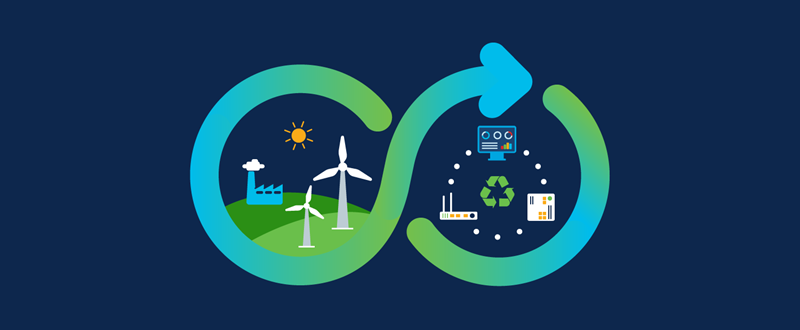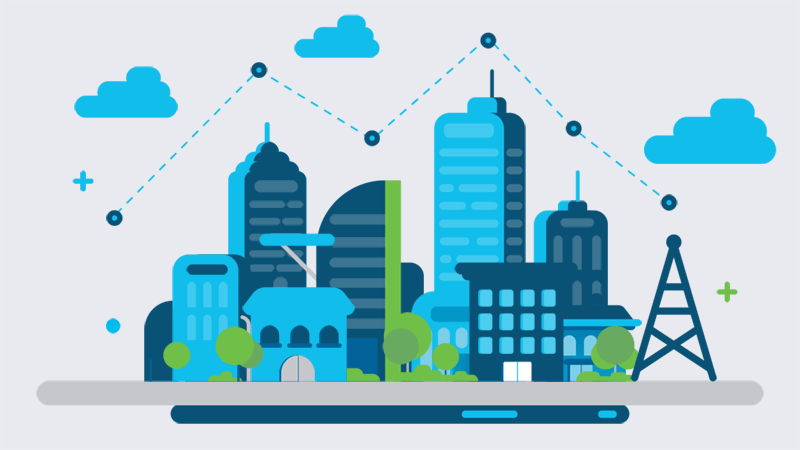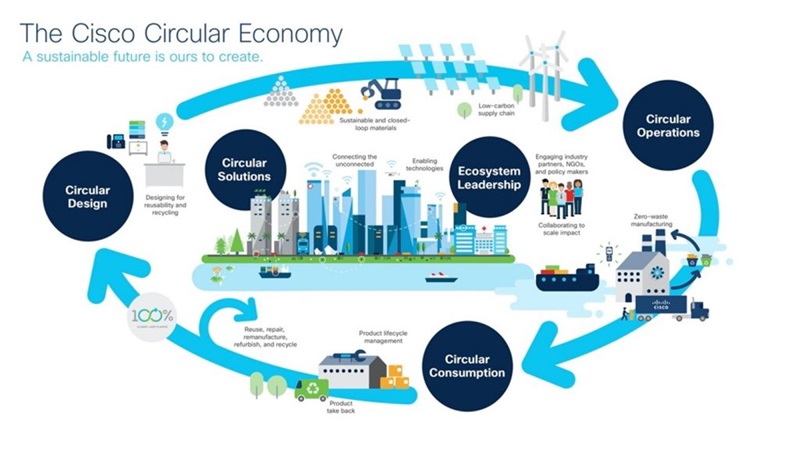The journey towards a sustainable internet is an ongoing global effort that encompasses several elements, which includes but not limited to, smart design, energy efficiency, and responsible consumption. One of the primary challenges is the internet’s massive energy consumption which significantly contributes to the world’s carbon emissions. Therefore, it’s essential to shift focus towards renewable energy sources to power data centers and networks. Google, for example, is championing this cause by committing to operate its data centers and offices on 24/7 carbon-free energy by 2030.
On another front, smart design of digital products and services can drastically reduce energy consumption. Techniques such as ‘green coding’ or ‘sustainable software engineering’ are increasingly being adopted by developers to create energy-efficient software. This involves selecting algorithms and data structures that minimize energy consumption and reduce the carbon footprint of digital products.
Moreover, the internet’s sustainability is also linked to the electronic waste problem. Millions of devices like computers, smartphones, and servers are discarded each year, creating substantial amounts of e-waste. Hence, steps must be taken to promote the reuse and recycling of electronic devices. Companies like Apple are already making strides in this direction by offering trade-in options for old devices and aiming to stop mining the earth for rare minerals and metals.
In addition, the digital divide, which refers to the gap in access to information technology, is another issue that needs to be addressed in the pursuit of a sustainable internet. Efforts should be made to ensure that the benefits of the internet are accessible to all, including those in remote and underserved areas. This includes making technology affordable and improving digital literacy.
Furthermore, the sustainability of the internet is also tied to ethical considerations. Issues such as privacy, data protection, and cyberbullying are of significant concern. Privacy-preserving technologies like end-to-end encryption can ensure data protection, while education and awareness can help combat cyberbullying.
Finally, the role of internet users cannot be overstated in moving towards a sustainable internet. Responsible internet usage includes reducing unnecessary data consumption, managing digital clutter, and supporting companies that prioritize sustainability. For instance, streaming videos in lower resolution when high-definition is not required can significantly reduce data consumption and thus energy use.
In conclusion, moving towards a sustainable internet requires a collective effort from governments, businesses, developers, and users. While the task may seem daunting, the benefits of a sustainable internet – reduced carbon emissions, efficient use of resources, improved access to technology, and enhanced privacy and security – make it a goal worth striving for. Through innovation, cooperation, and responsible usage, we can ensure that the internet continues to be a tool for positive change without compromising the health of our planet.

Understanding the Need for Sustainability
Understanding the need for sustainability is paramount in today’s rapidly changing world. With finite resources and an ever-growing population, we are faced with the challenge of ensuring our actions today do not compromise the ability of future generations to meet their needs. Sustainability is not merely a buzzword; it’s a fundamental necessity for our survival and prosperity.
The concept of sustainability goes beyond merely reducing waste or recycling; it encompasses a wide range of practices aimed at creating a balance between economic growth, social inclusion, and environmental protection. Everything we consume or use – be it food, energy, water, or materials – has a certain impact on our planet. If we continue to consume these resources at our current pace without considering their renewal, we risk depleting them, leading to scarcity, ecosystem imbalance, and even potential societal collapse.
Moreover, the effects of climate change are increasingly evident, further emphasizing the urgency for sustainable practices. Rising global temperatures, melting ice caps, frequent extreme weather events, and loss of biodiversity are just a few manifestations of our unsustainable actions. These changes not only threaten our environment but also pose significant risks to our health, economy, and social stability.
To mitigate these impacts, we must integrate sustainability into every aspect of our lives, from our individual behaviors to corporate strategies and public policies. We need to transition to renewable energy sources, promote sustainable agriculture, conserve water, reduce waste, and protect our biodiversity. Likewise, businesses need to adopt sustainable models that limit their environmental footprints while still achieving economic growth.
In conclusion, understanding the need for sustainability is not just about preserving the environment for its own sake; it’s about ensuring a livable, prosperous future for all. It’s about redefining our relationship with the planet, altering our consumption patterns, and fostering a culture that values long-term prosperity over short-term gains. It’s a complex, challenging task, yet it’s one we cannot afford to ignore.
Key Strategies for Reducing Internet Carbon Footprint
As the digital world continues to expand, so does its carbon footprint. Therefore, it is crucial to adopt key strategies for reducing internet carbon footprint. One of the primary strategies is advocating for greener data centers. Data centers, which store and process vast amounts of information, consume massive amounts of energy. Transitioning to renewable energy sources for powering these data centers can significantly reduce their carbon emissions. Companies can also improve energy efficiency by optimizing their server use and investing in energy-efficient equipment.
Another strategy is implementing digital minimalism. This involves reducing unnecessary digital consumption by deleting unused files, unsubscribing from unwanted emails, and streaming lower-resolution videos when high definition is not required. Such actions decrease the amount of data processed and stored, thus reducing energy consumption.
Furthermore, promoting remote work can also contribute to a lower carbon footprint. With fewer people commuting to work, there is a reduction in fuel consumption and subsequently fewer carbon emissions. However, it’s important to ensure that home offices are energy efficient to negate any potential increase in household energy use.
Additionally, companies can encourage the use of cloud-based services. Cloud computing is often more energy-efficient than traditional computing because it uses less hardware and allows for better utilization of resources.
Finally, individuals and organizations can support digital sustainability by raising awareness about the environmental impact of the internet. Educating people about the necessity of digital hygiene, such as regularly clearing cache and cookies, can lead to more mindful internet use.
In conclusion, reducing the internet’s carbon footprint requires a multi-faceted approach, including greener data centers, digital minimalism, remote work, cloud computing, and increased awareness. By adopting these strategies, we can create a more sustainable digital landscape that benefits not only us but also future generations.

Innovative Technologies Driving Green Internet Practices
Innovative technologies are propelling the adoption of environmentally friendly internet practices, as the world continues to grapple with environmental challenges. A prime example of this is data center virtualization, which allows multiple virtual servers to run on a single physical server, thus reducing the energy consumption linked to server operation. Cloud computing is another profound technology, offering businesses an opportunity to decrease their carbon footprint by allowing them to use only the computing resources they need, thereby reducing energy waste.
Furthermore, the advent of renewable energy sources for internet infrastructure is also a significant stride. Major tech companies are integrating solar and wind energy into their data centers, fostering a greener internet. Energy-efficient hardware is another key aspect. The development of low-energy servers and the advent of solid-state drives, which consume less power than traditional hard drives, are making significant contributions towards the greener internet.
Artificial Intelligence (AI) and machine learning algorithms are also playing a critical role in optimizing energy use and enhancing the efficiency of data centers. They are capable of predicting peak times, adjusting cooling systems and shutting down unused servers, consequently minimizing energy waste.
Another crucial aspect is the green web hosting services, which host websites on servers powered by renewable energy or purchase carbon offsets to minimize their environmental impact. Moreover, internet service providers are also strategically planning their infrastructure to reduce the distance data must travel, consequently decreasing the energy used in data transmission.
Lastly, the internet of things (IoT) is also driving green internet practices. By allowing devices to communicate directly with each other, IoT can enhance energy efficiency by streamlining processes and eliminating unnecessary energy usage.
To sum up, the emergence of advanced technologies is spearheading the move towards a more sustainable internet landscape. By integrating these innovations, we can ensure that our increasing reliance on the internet does not contribute to environmental degradation.
Challenges and Opportunities in Sustainable Internet Development
Sustainable internet development is a balance of challenges and opportunities. On one hand, it promises to revolutionize the digital landscape by offering efficient, eco-friendly solutions that contribute to a more sustainable future. It provides opportunities for businesses to reduce their carbon footprint, save energy, and promote responsible use of resources, thereby fulfilling their social responsibilities while also improving their bottom line. Furthermore, sustainable internet development can foster digital inclusivity by making internet access more affordable and widespread, especially in remote or underprivileged areas.
However, this sustainable transition is not without its hurdles. One major challenge in sustainable internet development is the high initial investment required to establish green infrastructure. Additionally, the constant evolution of technology makes it difficult to ensure long-term sustainability. For instance, new models of devices and upgrades in software often lead to electronic waste, unless proper recycling systems are in place. Besides, there is the challenge of creating and maintaining a reliable renewable energy source to power these systems in a sustainable way.
Moreover, the lack of awareness and knowledge about the importance and benefits of sustainable internet development among businesses and consumers can be a significant obstacle. This can hinder the adoption of sustainable practices and technologies. Therefore, it is crucial to promote education and training in this field to drive the shift towards sustainability in the digital world.
Despite these challenges, the opportunities provided by sustainable internet development far outweigh the obstacles. It can lead to economic growth, job creation, and improved quality of life. It can also enable the development of innovative digital solutions that address environmental and social issues. Therefore, it is necessary to address these challenges and seize the opportunities to ensure a sustainable future for the internet, and by extension, our planet.

How Individuals and Organizations Can Contribute
Individuals and organizations have the potential to make significant contributions to society, both locally and globally. They can contribute in various ways, such as through monetary donations, participating in volunteer work, or by raising awareness about important social issues. For instance, individuals can contribute their time and efforts to local community projects, such as tutoring children, cleaning up parks, or visiting the elderly. Additionally, they can donate to charities that align with their personal values and beliefs.
Organizations, on the other hand, often have more resources and reach than individuals, thus allowing them to make a larger impact. They can provide financial support to causes that resonate with their mission and vision, or they can establish their own initiatives to address societal challenges. Companies, for instance, can implement corporate social responsibility (CSR) programs that aim to improve the communities where they operate, or they can champion causes related to environment, education, healthcare, and so on.
Furthermore, both individuals and organizations can use their influence to raise awareness about issues they care about. This could be through social media campaigns, organizing events, or simply by engaging in conversations with their networks. The power of collective action should not be underestimated, as it can drive societal change and encourage others to contribute as well.
However, it’s crucial for both individuals and organizations to make their contributions in a responsible and ethical manner. This means considering the potential impacts of their actions, ensuring the transparency of their operations, and treating all stakeholders with respect and dignity. Ultimately, the goal should be to make a positive difference in the world, and this can be achieved when everyone plays their part.
